Goodbye My Chechnya
Photojournalist Diana Markosian spent the last year and half covering Russia's volatile North Caucasus region. In 2011, she moved to Chechnya where she started a personal project entitled "Goodbye My Chechnya," which documents the lives of young Muslim girls who witnessed the horrors of two wars and are now coming of age in a republic that is rapidly redefining itself as a Muslim state. The project will be exhibited at the Half King in New York City from Sept 11- Oct 30.
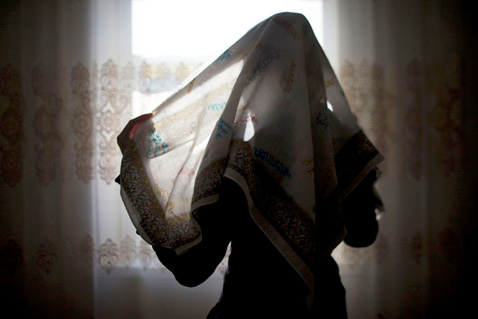 Seda Makhagieva, 15, wraps a pastel-colored head covering before leaving her home. Makhagieva says it's her duty as a Muslim to wear a hijab. Islam is quickly becoming the cornerstone of identity for youth in modern-day Chechnya.
Seda Makhagieva, 15, wraps a pastel-colored head covering before leaving her home. Makhagieva says it's her duty as a Muslim to wear a hijab. Islam is quickly becoming the cornerstone of identity for youth in modern-day Chechnya.
 Students at the Chechen State University sit in an auditorium before a performance. All females students must follow a strict Islamic dress code. Females have reported being harassed, some physically harmed for not wearing a head covering and long skirt.
Students at the Chechen State University sit in an auditorium before a performance. All females students must follow a strict Islamic dress code. Females have reported being harassed, some physically harmed for not wearing a head covering and long skirt.
 A woman on a date with her boyfriend in the village of Serzhen-Yurt. Couples on dates must meet in public and sit a distance from one another. All physical contact is forbidden before marriage.
A woman on a date with her boyfriend in the village of Serzhen-Yurt. Couples on dates must meet in public and sit a distance from one another. All physical contact is forbidden before marriage.
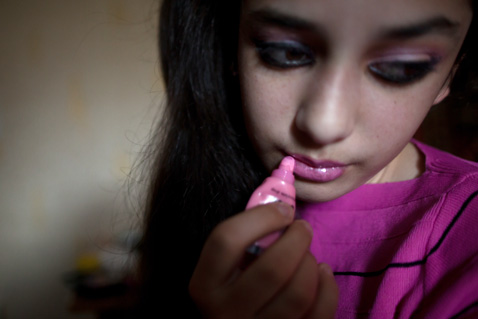
A Chechen teen, who considers herself a type of punk rock fan called "Emo," puts on pink lip gloss in her room. Chechen youth who have been influenced by the Western Emo subculture have become targets of violence.
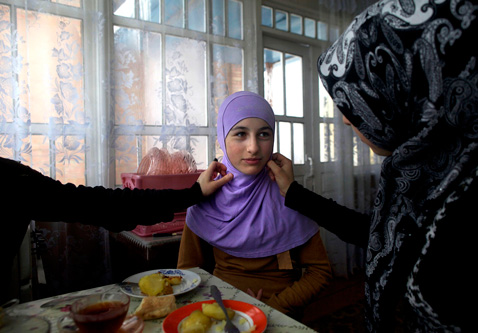 Seda Malakhadzheva, 15, sits beside her friends as they adjust her hijab. She started wearing the head-covering a year ago.
Seda Malakhadzheva, 15, sits beside her friends as they adjust her hijab. She started wearing the head-covering a year ago.
 Chechen dancers backstage at a concert hall in Grozny. A suicide bomber in 2009 detonated explosives near the concert hall. The explosion killed five people and left several others injured.
Chechen dancers backstage at a concert hall in Grozny. A suicide bomber in 2009 detonated explosives near the concert hall. The explosion killed five people and left several others injured.
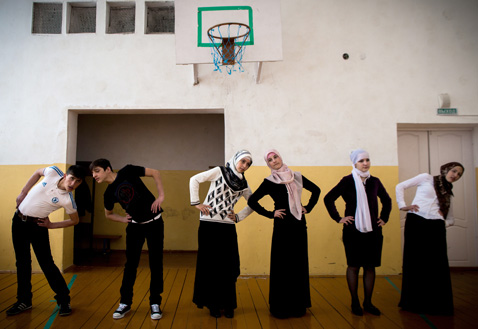 Gym class at School No 1 in the Chechen village of Serzhen-Yurt. The girls, all dressed in skirts with their heads wrapped in headscarves, say gym clothes violate Muslim dress code.
Gym class at School No 1 in the Chechen village of Serzhen-Yurt. The girls, all dressed in skirts with their heads wrapped in headscarves, say gym clothes violate Muslim dress code.
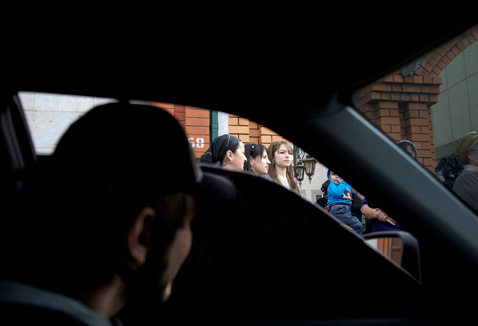 A teenage boy checks out a group of girls from his black tinted window in the town of Urus-Martan. Young women are often kidnapped off the street and married to men they have never met. Bride kidnapping continues to be an endemic problem.
A teenage boy checks out a group of girls from his black tinted window in the town of Urus-Martan. Young women are often kidnapped off the street and married to men they have never met. Bride kidnapping continues to be an endemic problem.
 Jamila Idalova, 16, on her wedding day. The teen bride was kidnapped by her boyfriend. Idalova's family eventually approved the marriage. Bridal kidnappings are outlawed under strongman Ramzan Kadyrov.
Jamila Idalova, 16, on her wedding day. The teen bride was kidnapped by her boyfriend. Idalova's family eventually approved the marriage. Bridal kidnappings are outlawed under strongman Ramzan Kadyrov.
 Chechen girls after school in front of the Heart of Chechnya mosque, the largest in Europe. All Chechen girls, despite religion, must wear a head covering in public schools and government buildings.
Chechen girls after school in front of the Heart of Chechnya mosque, the largest in Europe. All Chechen girls, despite religion, must wear a head covering in public schools and government buildings.
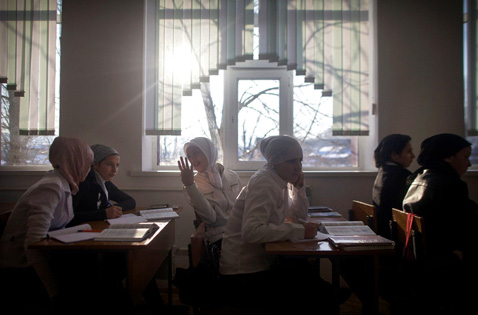 Half of the girls in the ninth grade at School No 1 in the Chechen village of Serzhen-Yurt wear the hijab. The head and neck covering is a sharp break from Chechen tradition.
Half of the girls in the ninth grade at School No 1 in the Chechen village of Serzhen-Yurt wear the hijab. The head and neck covering is a sharp break from Chechen tradition.
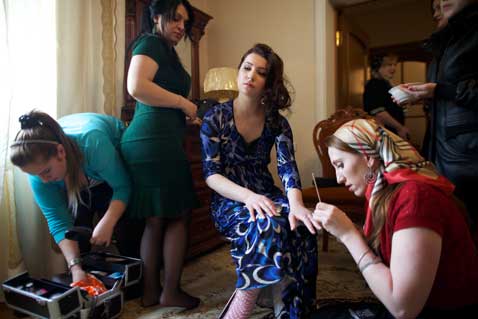 Layusa Ibragimova, 15, has her hair and nails done before her wedding. Her marriage to 19-year-old Ibragim Isaev was finalized by her father just weeks before.
Layusa Ibragimova, 15, has her hair and nails done before her wedding. Her marriage to 19-year-old Ibragim Isaev was finalized by her father just weeks before.
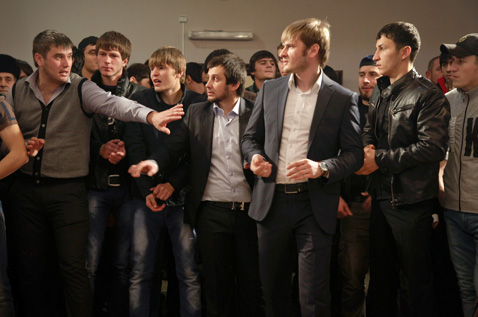 A group of Chechen men at a party, standing at the opposite end of the women. In Chechnya, under strongman Ramzan Kadyrov, gender segregation is being enforced.
A group of Chechen men at a party, standing at the opposite end of the women. In Chechnya, under strongman Ramzan Kadyrov, gender segregation is being enforced.
 Elina Aleroyeva, 25, along with her child at their home in Grozny. Aleroyeva says her husband was kidnapped by federal security forces on May 9, 2011, accused of being a militant. Disappearances used to be a signature abuse in both Chechen wars and continue to take place.
Elina Aleroyeva, 25, along with her child at their home in Grozny. Aleroyeva says her husband was kidnapped by federal security forces on May 9, 2011, accused of being a militant. Disappearances used to be a signature abuse in both Chechen wars and continue to take place.
 At sunset in the outskirts of Grozny, Kazbek Mutsaev, 29, fires celebratory gun shots as part of an age-old wedding tradition in Chechnya.
At sunset in the outskirts of Grozny, Kazbek Mutsaev, 29, fires celebratory gun shots as part of an age-old wedding tradition in Chechnya.
Photo Essay by Diana Markosian